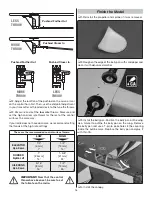
28
ENGINE SAFETY PRECAUTIONS
Failure to follow these safety precautions may result
in severe injury to yourself and others.
●
Keep all engine fuel in a safe place, away from high
heat, sparks or fl ames, as fuel is very fl ammable. Do
not smoke near the engine or fuel; and remember that
engine exhaust gives off a great deal of deadly carbon
monoxide. Therefore
do not run the engine in a closed
room or garage
.
●
Get help from an experienced pilot when learning to
operate engines.
●
Use safety glasses when starting or running engines.
●
Use an electric starter to start the engine. If you do fl ip
the propeller with your fi ngers use a “chicken stick”.
●
Do not run the engine in an area of loose gravel or
sand; the propeller may throw such material in your
face or eyes.
●
Keep your face and body as well as all spectators away
from the plane of rotation of the propeller as you start
and run the engine.
●
Keep these items away from the prop: loose clothing,
shirt sleeves, ties, scarfs, long hair or loose objects
such as pencils or screwdrivers that may fall out of
shirt or jacket pockets into the prop.
●
The engine and muffl er get hot! Do not touch them
during or right after operation. Make sure fuel lines
are in good condition so fuel will not leak onto a hot
engine, causing a fi re.
ELECTRIC MOTOR
SAFETY PRECAUTIONS
●
WARNING:
Read the entire instruction sheet included
with your motor batteries. Failure to follow the
instructions could cause permanent damage to the
battery and its surroundings and cause bodily harm!
●
ALWAYS
remove the propeller if the motor batteries
will be connected while working on the plane.
●
ALWAYS
remove the motor batteries when charging.
●
ALWAYS
follow the charging instructions included with
your charger for charging LiPo batteries. LiPo batteries
can cause serious damage if misused.
●
ALWAYS
set the fail safe on your radio to prevent the
motor from starting if the signal is lost. Once the motor
batteries are connected the electric motor can start at
any time.
●
ALWAYS
unplug the motor batteries fi rst.
●
ALWAYS
set the charger’s output volts to match the
battery volts.
●
ALWAYS
charge a LiPo battery in a fi reproof location.
●
ALWAYS
KEEP OUT OF THE REACH OF CHILDREN.
●
ALWAYS
remove the battery from the plane after a crash.
Set it aside in a safe location for at least 20 minutes. If
the battery is damaged in the crash it could catch fi re.
●
NEVER
touch the motor during or right after operation.
The motor gets hot.
●
NEVER
switch off the transmitter with the motor
batteries plugged in.
●
NEVER
use a NiCd/NiMH peak charger to charge a
LiPo battery.
●
NEVER
charge LiPo batteries in excess of 4.20V per
cell unless stated on the battery.
●
NEVER
charge through the “discharge” lead.
●
NEVER
charge at currents greater than 1C unless the
battery is rated for a higher charge rate.
●
NEVER
trickle charge a LiPo battery.
●
NEVER
allow the battery temperature to exceed 150
degrees F (65 degrees C).
●
NEVER
disassemble or modify the pack wiring in any
way or puncture the cells.
●
NEVER
discharge a LiPo battery below 3.0V per cell.
●
NEVER
place the battery or charger on combustible
materials or leave it unattended during charge or
discharge.
●
NEVER
charge the battery in the plane.
●
NEVER
use water to try and put out a LiPo fi re. If the
battery starts to swell, quickly move the battery to a
safe location, preferably outside. Place it in a bucket,
covering the battery with sand.
●
ONLY
charge through the charge or balance lead.
●
ONLY
use a LiPo approved charger.
Summary of Contents for ULTRA SPORT 46
Page 31: ...Notes 31...





































